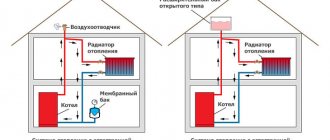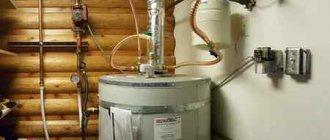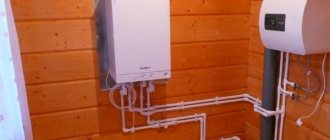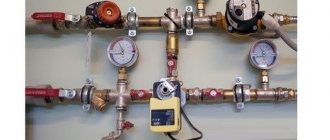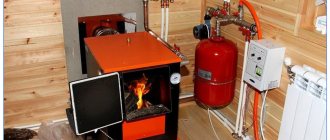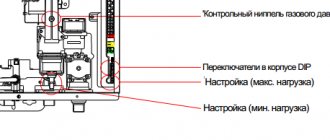A fairly common problem when using double-circuit gas boilers, when hot water turns on and the pressure inside the boiler begins to drop sharply. The pressure drops almost to zero, and warm water has a pungent odor. Sometimes it even happens that due to a pressure reduction error, the heating boiler automatically turns off. Another case is when a drop in pressure is observed when the water supply in the house is temporarily interrupted, after which the boiler fuses do not allow it to start again. When you try to turn it on, the tank will display an error about pressure problems and simply will not turn on. In general, a drop in pressure in the boiler is very harmful for the boiler and water supply systems, so you need to immediately diagnose the problem, and then begin to immediately solve it. What's the matter and what needs to be done, read below.
What is the problem with low blood pressure?
There are many reasons why such a malfunction can occur. Among the most likely ones are problems with the tank, and sometimes various damage to the heat exchanger. However, in most cases, the reason for the pressure drop in a gas boiler lies in the non-working state of the make-up tap. It may not be closed tightly, or it may be completely faulty. Even minor mechanical damage to the faucet can cause a drop in pressure. Otherwise it is called a connected valve or fill tap. It is installed mainly on combined or double-circuit boilers. The fact is that the water supply system and the heating circuit communicate through an open or faulty fill valve, but this should not happen. The consequence of this is equalization of pressure, since the two systems are connected to each other. Typically, the internal pressure inside the water supply is much greater than it should be in a heating system. Therefore, through the hole this pressure quickly dissipates, and in the end it turns out that, in fact, the boiler and the water supply will have the same pressure.
At the same time, the boiler continues to operate, but the pressure indicators remain the same, since the water, expanding due to heating, flows into the water supply. As soon as we turn on the hot water, the pressure immediately drops. That is, due to an open tap, the boiler and water supply are essentially communicating vessels, trying to balance each other. This explains the strong unpleasant smell, because before water flows out of the tap, it passes through the water supply system, into which the already used water is drained. But as soon as you turn off the hot water, the pressure in the entire system returns to normal. It returns to the state it was in when cold water entered the house. But the pressure in the boiler remains low, since water fills the boiler through the same feed tap.
It follows that this problem causes the tank to constantly fill and empty. This is very harmful for the entire system, and there are two reasons for this:
- Oxygen that tap water brings with it. It oxidizes all pipes, which leads to their malfunction. Metal corrosion has a very negative effect on it, which can ultimately lead to serious problems. Pipes subject to corrosion are destroyed and after some time water begins to pass through them. Repairs can be very expensive since all the equipment will have to be replaced. A constant flow of fresh water reduces the service life of equipment by five to ten times.
- Salts contained in large quantities in the same water. They lead to the formation of scale, and this is also not beneficial for the boiler. It will be almost impossible to clean this scale from the pipes without damaging them. Leading manufacturers of heating equipment strongly recommend that the make-up should not be greater than the volume of the boiler, tripled.
Navien boiler error 10
This error is related to the smoke removal system of the gas boiler. Combustion products must be removed; for this purpose, the boilers are equipped with a fan. To control the operation of the fan and determine the presence of permissible draft for boiler operation, a differential relay is used, which is connected to the turbine by two plastic tubes. When the fan is running, a vacuum is created, the relay closes, and the boiler functions normally.
Reasons for error 10
may be a clogged chimney, the presence of reverse draft, or incorrect connection of the air pressure control sensor to the fan. For the latter case, you need to check that the yellow tube is connected to the bottom of the fan, and the transparent one is connected to the top, and the tubes themselves are not damaged, deformed or condensation inside.
Increased resistance in the chimney can occur due to direct gusts of wind or blockage of the chimney (bird nest or cobwebs, freezing in winter). That's right, the location of the chimney should be taken into account the direction of the winds of a particular region at the design stage and the chimney should not be installed on the leeward side of the house.
We focused on the most common malfunctions of Navien boilers, but in fact there are significantly more error codes. Methods for checking and troubleshooting are the topic of a separate article. For convenience, here is a summary table of codes with a brief description:
Faithfully, the navien boiler worked for me for seven years, heating a two-room apartment and heating water in the hot water system at two points. The apartment area is small, so the operating mode is quite gentle. But we like to include hot water.
Among the malfunctions during all this time, I changed the three-way valve - the love for cleanliness and water procedures affected it. The cause of the malfunction was an electrical microswitch whose contact plate had broken. I was too lazy to tinker with a soldering iron, so the unit was replaced with a new one. The asking price is about two thousand rubles. In addition, I removed and washed the automatic air vent a couple of times. Some kind of garbage came up. But in general, I am very pleased with the performance of the device, especially considering that it was purchased at a cost half as much as its counterparts on the market.
So, during the inspection it was found that the case was full of dust and all sorts of unfortunate insects that were sucked in by the air flow from the fan. A couple of minutes of vacuum cleaner operation, wet cleaning and complete order. Opening the combustion chamber showed that on the heat exchanger in the lower part there is a coating of red sludge from combustion products, and in the upper part there is debris and oxidation as a result of exposure to condensate from combustion products.
The combustion chamber. This is actually the boiler itself. If we compare it with classic floor-standing boilers, then in terms of power it is analogous to a boiler like Don 16 or AOGV 16, which of course will not fit in a bathroom...
To clean it, I removed the combustion chamber, carefully cleaned the heat exchanger honeycombs with a brush, washed the outside with water pressure from the tap and removed oxidation using Liqui Moli carburetor cleaner. It came in handy. I also used it to clean the automatic air vent valve installed on the circulation pump housing. Inside, the heat exchanger is practically free of contamination - there is only a small yellowish coating, which could be removed with citric acid. But this time I decided to skip this procedure. I washed the gas burner with water. A lot of dust passes through this “vacuum cleaner” and some of it, of course, settles, interfering with the normal combustion process. Monitoring the air pressure in the expansion tank showed its complete absence. An attempt to restore it showed a membrane rupture. Replacement tank. Reassemble in reverse order. Be careful not to damage the gaskets. By the way, they are all in good condition and factory lubricated. Grease had to be applied to the chimney rubber bands during assembly. Filled it with water and pressed it. That's all, the device is ready for use. After turning it on, I checked it in all modes and was pleased with the result. Costs 3,500 rubles for an expansion tank. I will give advice to those who like to save money: a failed expansion tank of a wall-mounted boiler can be left alone. To compensate for the thermal expansion of the coolant, in any convenient place you can embed and connect any simple and inexpensive tank for heating systems of suitable volume.
How to solve the pressure problem?
The very first thing to do in such cases is to check the valve. Before starting the test, make sure that the make-up valve is closed as tightly as possible. Check what happens when the gas boiler is turned off. To do this, disconnect it from the power supply. The same thing happens even when it is turned off - there is only one solution - call a service center that will replace the faucet for you. It is not recommended to replace the faucet yourself at home, as this work may require special equipment.
If the pressure drops only while the boiler is on, and this does not happen while warm water is being used, but only when the boiler is turned on and off, then the cause of the breakdown is most likely in the expansion tank. You can easily fix the problem yourself, at home. It is enough to find a fault by external inspection, most often it is some kind of scratch or small hole, then patch it with special glue. If the hole is large, then repairing it will require the help of specialists or a complete replacement of the expansion tank.
Placing containers in heating units
Today, there are 2 main variations of expansion tanks depending on the place allocated to them in the system. Among them:
- Built-in closed container. Most new units these days come with expansion tanks by default. The volume of the structure is selected depending on the size and productivity indicators of a particular boiler. If a significant load is expected on the tank, then its volume should be rather large.
- Open external tank. Such tanks are often used when coolant circulation occurs under the influence of gravity. This design is an open tank, which is mounted at the highest point of the entire heating system. The liquid, displaced as the temperature of the coolant rises, enters an open container. At the same time, when the water temperature drops, the residues from the tank enter the system under the influence of gravity and atmospheric pressure.
How to monitor your blood pressure?
Each equipment must have sensors to monitor the operation of the unit, especially a low-pressure steam boiler. They collect information about the system and provide it to the user through a monitor or other devices. Indicators in the system are considered normal at a level of 1.5 to 2 atm. If the indicator is high or, on the contrary, does not reach the required interval, there are some problems with the boiler.
It must be remembered that insufficient pressure occurs only in a boiler system with a pump. In the case where natural circulation is provided, the owners may encounter “airing”. You can restore it and also remove the air yourself, but you need to have certain knowledge to do this. If the owners do not have enough information, it is better to call a specialist.
Norm and control
The heating system is adversely affected by both excessively high and low pressure, measured in atmospheres. In this case, the normal level is 1.5-2 atmospheres.
Healthy! In multi-storey buildings with central heating, this standard is slightly higher, since here the pipes must also withstand water hammer.
Types of pressure in the system
In double-circuit wall heating systems, pressure is divided into the following types:
- static - formed under the influence of gravitational forces on the coolant; increases by 0.1 bar with an increase in height by one meter;
- dynamic - created through forced operation of the pumping unit or an increase in temperature when the working medium moves;
- working - static + dynamic;
- excess - the difference between atmospheric and measured;
- absolute - excess + atmospheric;
- nominal - indicated by the manufacturer in the technical documents for the gas boiler;
- maximum - the maximum permissible, threshold value that the device can withstand;
- limit (pressure testing) - the value at which the device is tested; can exceed the operating level by one and a half times.
Causes of pressure drop
Despite the fact that a gas boiler is a complex engineering system, the pressure in it can drop due to just a few reasons:
- open leakage of liquid from the system;
- Power outages frequently or for long periods of time;
- problems with the expansion tank;
- The power of the double-circuit boiler is incorrectly calculated.
Typically, low pressure in the boiler automatically stops its operation. So, for example, if the coolant level in the heating system drops to a minimum, then it simply stops flowing into the boiler. If there is insufficient atmosphere in the gas pipe, the equipment automatically turns off. To solve the last problem, you need to call a specialist from the appropriate service, who has all the necessary knowledge and tools that allow him to determine the cause and get rid of it. At a minimum, he knows the tools that allow him to raise the readings to the required value. It is not recommended to solve this problem yourself.
In addition, insufficient pressure appears due to the formation of air pockets, which arise due to several reasons:
- improper filling of the system with coolant;
- after water got into the heating, the air was not removed immediately;
- insufficient sealing of seams;
- clogging;
- constantly broken air bleed valve.
Why does the pressure in the heating system drop and how to fix it
In the modern world, almost every house or apartment has some kind of heating system installed. Such a system cannot properly heat rooms without the necessary pressure. In this article we will look at the 3 main reasons why the pressure in the heating system drops
Reason 1. Dumping excess air
During the first start-up, air gradually leaves the system. Therefore, the pressure in the heating system drops . Initially, it comes out of the boilers themselves. And since there are automatic air vents on the boilers and inside the boilers, usually on the walls, the air comes out of the boilers on its own.
Plus, when you start a wall-mounted boiler, there is a screw on the boiler pump that serves to bleed air right down the middle of the pump. If you unscrew it, air will come out first. Then water will flow in a thin stream. After this, you need to lightly tighten the screw, usually it is on a rubber band, and after that the wall-mounted boiler will not contain air and will be able to function normally.
Often, upon first start-up, the pressure in the heating system of water heated floors drops significantly. Huge floors can be one hundred or two hundred square meters in size. Below them are long pipes that initially contain air. Subsequently, they are filled with coolant.
So when you start the heated floor circulation pump, the automatic air vents that are located on the heated floor manifold immediately begin to hiss. Those. The coolant that begins to circulate through the water-heated floor begins to push this air into the collector.
And as a result, air begins to flow out of the air vents intensively, especially at the very beginning. This causes the pressure in the heating system to drop.
It is imperative to monitor the pressure on the safety group and on the pressure gauge of the wall-mounted boiler, and if necessary, top it up. Air may be escaping from the boiler coil. It can also break through to an automatic air vent. And possibly to radiators on other floors. It will accumulate in radiators, so they must have Mayevsky taps. If you see that the radiator has stopped heating, open the Mayevsky tap. At first the air will also hiss, then water will flow in a thin stream. This means that the air has completely escaped.
After the start of operation, for another week or two, maybe longer, air may escape from the water-heated floor. Accordingly, the pressure in the heating system will drop. This should not scare you, because over time the intensity will subside and after a few weeks it will practically stop.
Reason 2. Air is escaping from the expansion tank
A few months after the start of operation, the pressure in the heating system may drop unpredictably when air leaves the membrane expansion tank. There is a nipple at the top of the tank, which gradually, over the course of perhaps several months, bleeds the air. And it turns out that under the influence of the coolant, all the air is squeezed out and the entire expansion tank is filled with coolant.
This is due to the fact that when the boiler is turned on, the coolant heats up, the pressure in the system quickly begins to increase, and the following happens: when the pressure becomes higher than permissible, the safety valve is activated and relieves the pressure. And when the pressure decreases, you gradually feed it, and this happens more and more often.
And a condition imperceptibly occurs in the expansion tank when the entire or almost the entire tank is filled with coolant (water) and there is practically no air in it. Consequently, the pressure rises when the boiler starts operating, and as soon as it rises above the limit, the safety valve, which is precisely designed to protect the system, is activated, and the coolant is discharged.
Accordingly, the pressure in the heating system drops.
Reason 3. Leak in the heating system
And, of course, the most unpleasant case of loss of pressure in a heating system is a leak. It can be either in a visible place or appear somewhere where it is difficult to visually detect. Regardless of its location, it will sooner or later make itself felt.
For example, if a leak occurred inside a water-heated floor. This happens when someone accidentally drills into his branch, either from above or below. This is easy to detect, because a stain immediately appears or even water gushes out like a fountain. To eliminate this problem, it is necessary, of course, to carefully disassemble the floor at the leak site, install the necessary coupling, and, upon completion of the installation, re-cement this area.
Example one
Let's say you come in between pump operation and see that the pressure has dropped. We fed it to the standard position. And they left. Next, the boiler completed a one-time operation cycle, heated up and cooled down, and you may not even know that at this time the safety valve was activated. And without knowing this, you again have to replenish the pressure, without understanding the true reason for what happened to the coolant and why the pressure drops so quickly.
What to do?
There are several main features that must be adhered to if there is a pressure drop in the system:
- A decrease in water atmosphere indicates problems with the boiler and the entire heating system. How to increase the values when the pressure gauge indicates that the system is below normal? It’s simple – you just need to use the refill valve to add the required amount.
- If after this there is also a drop in atmosphere, there is clearly a hole somewhere that needs to be repaired urgently. It is advisable to seek help from a specialist, since further independent movements can only worsen the condition.
- Be sure to inspect the entire heating in a circle. Sometimes there are situations when the pressure level is increased and as a result the joints or seams of the pipes diverge - a minimal leak appears. Over time, the pressure gauge needle drops. If such a problem is discovered, it must be corrected as soon as possible.
- If nothing is found, it is better to invite a specialist who will check the functionality of the expansion tank and fully diagnose every meter of the structure.
Differences between Navien Ace and Navien Delux
Navien Delux is a modified model that replaced Navien Ace. Navien Delux Coaxial is a series of boilers with two heat exchangers with a power from 10 to 30 kW with a closed combustion chamber and forced smoke removal using a turbine. The manufacturer notes the following features of Navien Delux:
Frost protection system. Unlike boilers from other manufacturers, in addition to automatically turning on the burner when the temperature drops below 6 degrees, at temperatures below 10 degrees the boiler ensures continuous movement of the coolant by activating the circulation pump.
Fan with variable speed. Navien Delux boilers are equipped with a turbine with adjustable blade rotation speed depending on the readings of a special air pressure sensor. This ensures an optimal gas-air mixture ratio and increases boiler performance.
The heat exchanger is made of stainless steel. By using a fan with variable rotation speed and increasing combustion efficiency, it became possible to replace the copper heat exchanger with a stainless steel heat exchanger, which certainly has a significantly longer service life.
It is also noted that the boilers are protected from the influence of mains voltage surges by a special protective chip and the ability to operate at low (up to 4 mBar) pressure of main gas and water. In other words, the manufacturer tried to make a product that is maximally adapted to the worst operating conditions.

